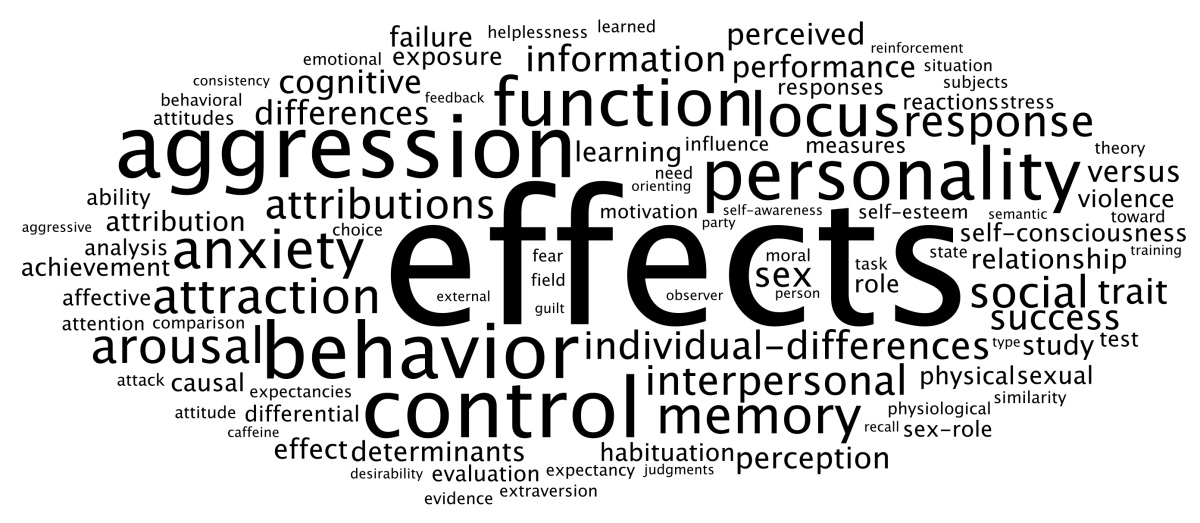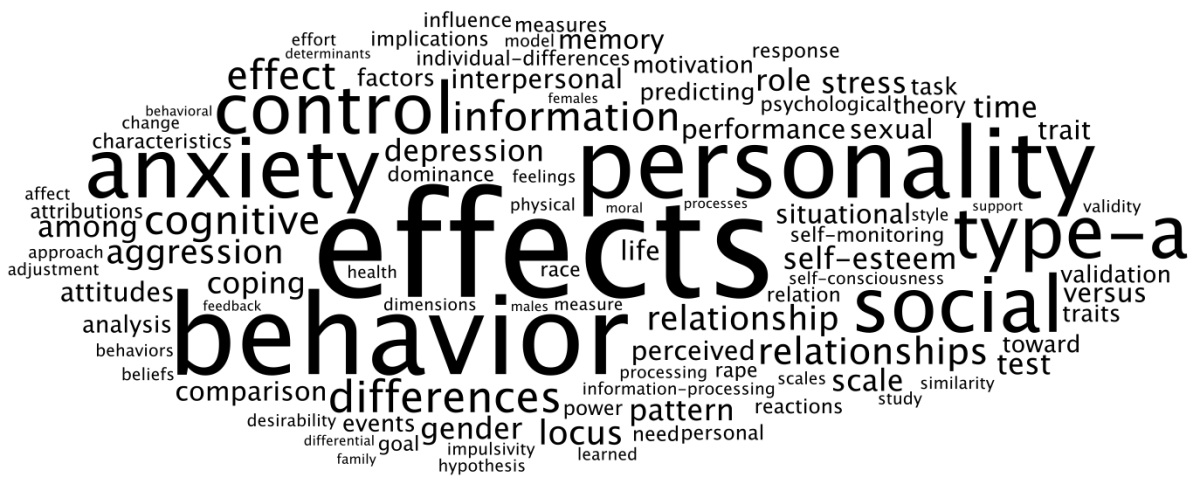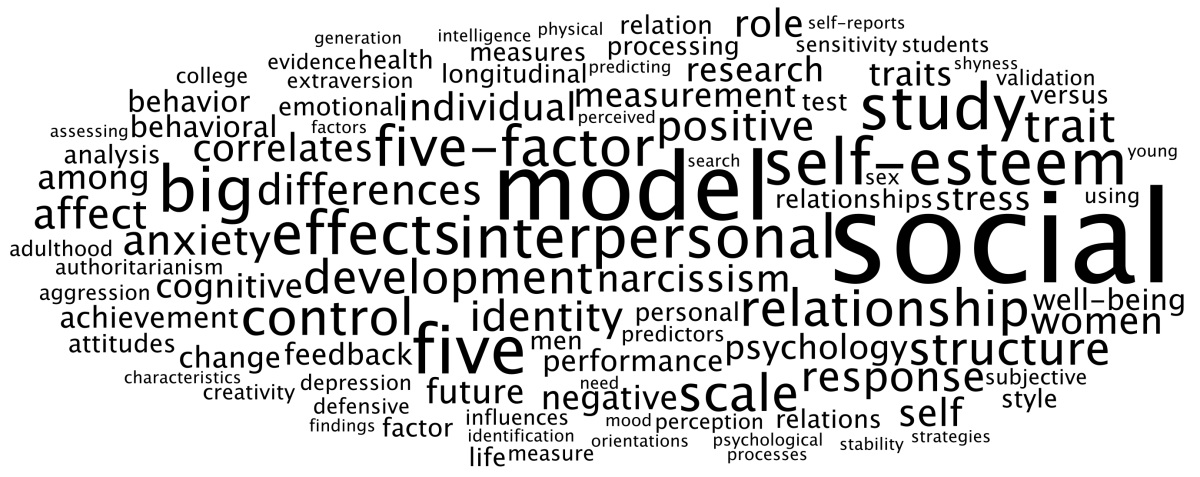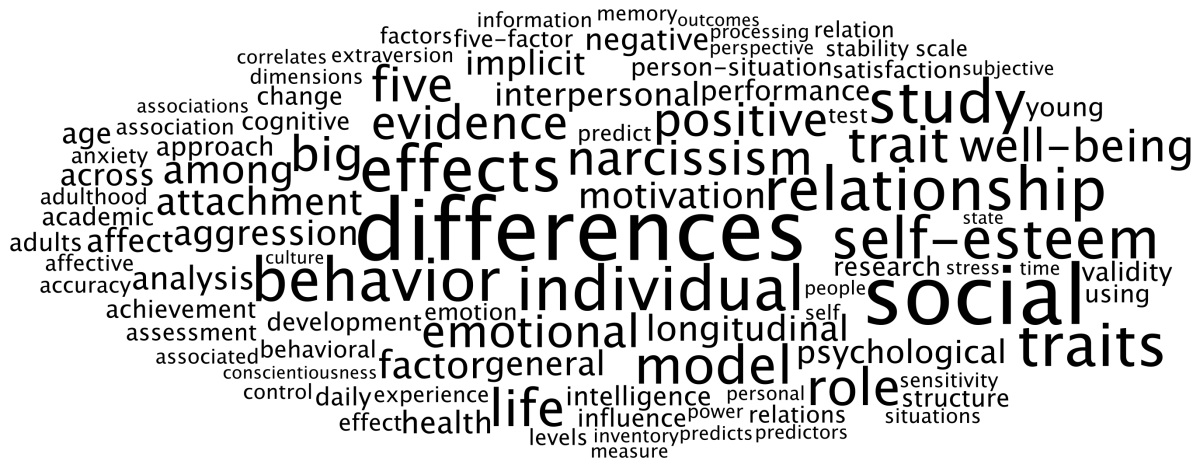“Personality” Rises to the Top: 40 Years of JRP Titles, 1973–2012
Gregory Webster
 How can we learn about trends in personality research over the past 40 years? One way is to examine the article titles that authors choose . To this end, I examined the title words of every article published in ARP’s flagship journal, the Journal of Research in Personality (JRP), from its inaugural issue in 1973 to its December 2012 issue (21,900 title words for 1,954 articles). I obtained JRP’s title data using my university’s online subscription to Thomson Reuters’ Web of Knowledge database (http://wokinfo.com). I then grouped the 40 years of data into four decades and made word clouds (Figure 1) for each decade using Wordle (http://wordle.net). Each word cloud shows the top 100 title words for its respective decade, with word sizes proportional to word frequency ( larger size = higher frequency).
How can we learn about trends in personality research over the past 40 years? One way is to examine the article titles that authors choose . To this end, I examined the title words of every article published in ARP’s flagship journal, the Journal of Research in Personality (JRP), from its inaugural issue in 1973 to its December 2012 issue (21,900 title words for 1,954 articles). I obtained JRP’s title data using my university’s online subscription to Thomson Reuters’ Web of Knowledge database (http://wokinfo.com). I then grouped the 40 years of data into four decades and made word clouds (Figure 1) for each decade using Wordle (http://wordle.net). Each word cloud shows the top 100 title words for its respective decade, with word sizes proportional to word frequency ( larger size = higher frequency).
Figure 1. Title word frequency clouds (created using Wordle.net; 100-word limit) for all articles published in the Journal of Research in Personality in the four decades from 1973 to 2012. The decades are ordered from earliest (1973–1982, top) to most recent (2003–2012, bottom). Word size is proportionate to word frequency, with larger words being more frequent. The bottom two word clouds exclude the word “Personality”, so that it is easier to see other words.
Table 1 shows the top 20 title words for each decade, along with their ranks and per-article percentages. Between JRP’s first (1973–1982) and fourth (2003–2012) decades, “Personality” grew from appearing in 6.2% of titles to 31.7% (+409%). Implying increased integration between social and personality psychology, “Social” grew from 3.8% to 6.5% (+70%). Perhaps echoing psychology’s (unfortunate) shift away from studying actual behavior (see Baumeister, Vohs, & Funder, 2007), “Behavior” decreased from 6.7% to 4.7% (-29%). The emergence of the Big Five or Five-Factor Model of personality in the late 1980s and early 1990s became apparent between JRP’s second and third decades, when the words “Big,” “Five,” “Five-Factor,” and “Model” each debuted among the top 10 title words. Between the second and fourth decades of JRP, some personality psychologists also appeared to embrace the scientific study of the self, as “Self-Esteem” increased from 2.5% to 4.6% (+85%). “Aggression” abated between JRP’s first and second decades, from 7.7% to 2.8% (-64%)—and was absent from the top 20 words in subsequent decades—perhaps reflecting aggression research’s gradual decline since its zenith in the 1970s.
1973–1982 (418 articles) |
|
1983–1992 (361 articles) |
|
1993–2002 (329 articles) |
|
2003–2012 (846 articles) |
||||||||
Rank |
Title word |
% |
|
Rank |
Title word |
% |
|
Rank |
Title word |
% |
|
Rank |
Title word |
% |
1.0 |
Effects |
16.0 |
|
1.0 |
Effects |
11.9 |
|
1.0 |
Personality |
28.3 |
|
1.0 |
Personality |
31.7 |
2.0 |
Aggression |
7.7 |
|
2.0 |
Behavior |
9.1 |
|
2.0 |
Social |
9.1 |
|
2.0 |
Differences |
6.9 |
3.0 |
Control |
7.2 |
|
3.0 |
Personality |
8.0 |
|
3.0 |
Model |
6.7 |
|
3.0 |
Social |
6.5 |
4.0 |
Behavior |
6.7 |
|
4.0 |
Anxiety |
6.9 |
|
4.0 |
Five |
4.9 |
|
4.0 |
Effects |
5.1 |
5.0 |
Personality |
6.2 |
|
5.0 |
Social |
6.4 |
|
6.0 |
Study |
4.6 |
|
5.0 |
Individual |
5.0 |
6.0 |
Function |
5.7 |
|
6.0 |
Type-A |
6.1 |
|
6.0 |
Big |
4.6 |
|
7.0 |
Traits |
4.8 |
7.0 |
Locus |
5.3 |
|
7.0 |
Control |
5.8 |
|
6.0 |
Self-Esteem |
4.6 |
|
7.0 |
Relationship |
4.8 |
8.0 |
Anxiety |
4.8 |
|
8.0 |
Differences |
3.6 |
|
8.5 |
Effects |
4.3 |
|
7.0 |
Study |
4.8 |
9.0 |
Memory |
4.5 |
|
10.0 |
Information |
3.3 |
|
8.5 |
Interpersonal |
4.3 |
|
9.0 |
Behavior |
4.7 |
10.5 |
Arousal |
4.3 |
|
10.0 |
Cognitive |
3.3 |
|
10.0 |
Five-Factor |
4.0 |
|
10.0 |
Self-Esteem |
4.6 |
10.5 |
Attraction |
4.3 |
|
10.0 |
Effect |
3.3 |
|
12.0 |
Control |
3.6 |
|
11.0 |
Model |
4.3 |
12.5 |
Response |
3.8 |
|
12.0 |
Relationships |
3.0 |
|
12.0 |
Scale |
3.6 |
|
13.0 |
Role |
4.1 |
12.5 |
Social |
3.8 |
|
14.0 |
Locus |
2.8 |
|
12.0 |
Relationship |
3.6 |
|
13.0 |
Trait |
4.1 |
14.5 |
Attributions |
3.6 |
|
14.0 |
Aggression |
2.8 |
|
15.0 |
Development |
3.3 |
|
13.0 |
Life |
4.1 |
14.5 |
Interpersonal |
3.6 |
|
14.0 |
Relationship |
2.8 |
|
15.0 |
Trait |
3.3 |
|
16.0 |
Big |
3.9 |
16.0 |
Individual-Differences |
3.3 |
|
16.0 |
Pattern |
2.5 |
|
15.0 |
Structure |
3.3 |
|
16.0 |
Five |
3.9 |
18.5 |
Success |
3.1 |
|
20.5 |
Role |
2.5 |
|
19.0 |
Identity |
3.0 |
|
16.0 |
Narcissism |
3.9 |
18.5 |
Information |
3.1 |
|
20.5 |
Coping |
2.5 |
|
19.0 |
Response |
3.0 |
|
18.5 |
Positive |
3.8 |
18.5 |
Trait |
3.1 |
|
20.5 |
Time |
2.5 |
|
19.0 |
Anxiety |
3.0 |
|
18.5 |
Evidence |
3.8 |
18.5 |
Sex |
3.1 |
|
20.5 |
Depression |
2.5 |
|
19.0 |
Positive |
3.0 |
|
20.5 |
Well-Being |
3.7 |
|
|
|
|
20.5 |
Test |
2.5 |
|
19.0 |
Affect |
3.0 |
|
20.5 |
Emotional |
3.7 |
|
|
|
|
20.5 |
Self-Esteem |
2.5 |
|
|
|
|
|
|
|
|
|
|
|
|
20.5 |
Scale |
2.5 |
|
|
|
|
|
|
|
|
|
|
|
|
20.5 |
Gender |
2.5 |
|
|
|
|
|
|
|
|
|
|
|
|
20.5 |
Stress |
2.5 |
|
|
|
|
|
|
|
|
Table 1. Top 20 title words per article in the Journal of Research in Personality by decade, 1973–2012.
Overall, these JRP title word frequency analyses suggest both change and consistency in the topics studied by personality psychologists over time. Some words, such as “trait,” were fairly stable , whereas others, such as “personality,” grew surprisingly in frequency. For similar title word analyses of SPSP poster titles, see Webster and Nichols (2009). For a comparison with evolutionary psychology, see Webster, Jonason, and Schember (2009).
References
Baumeister, R. F., Vohs, K. D., Funder, D. C. (2007). Psychology as the science of self-reports and finger movements: What ever happened to actual behavior? Perspectives on Psychological Science, 2, 396–403.
McCrea, R. R., & Costa, P. T., Jr. (1999). A five-factor model of personality. In L. A. Pervin & O. P. John (Eds.), Handbook of personality: Theory and research (2nd ed., pp. 139–153). New York: Guilford.
Webster, G. D., Jonason, P. K., & Schember, T. O. (2009). Hot topics and popular papers in evolutionary psychology: Analyses of title words and citation counts in Evolution and Human Behavior, 1979–2008. Evolutionary Psychology, 7, 348–362. http://epjournal.net/wp-content/uploads/ep07348362.pdf
Webster, G. D., & Nichols, A. L. (2009, Spring). Trends and hot topics in personality and social psychology: An analysis of SPSP poster title words from 2005 and 2009. Dialogue, 24(1), 16–19. http://c.ymcdn.com/sites/www.spsp.org/resource/resmgr/dialogue/dialogue241.pdf



